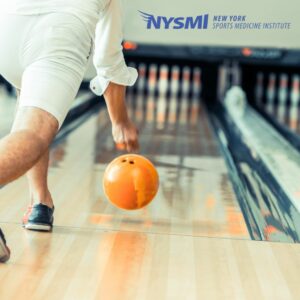
Bowler’s Elbow – Causes, Symptoms, and Treatment
Bowler’s elbow, also known as medial epicondylitis, is a condition that affects many people, not just athletes. This condition can cause significant discomfort and limit your ability to perform everyday activities. At New York Sports Medicine Institute, our team of specialists in orthopedic Glen Rock, NJ, is dedicated to diagnosing and treating bowler’s elbow to ensure you can return to your daily routine without pain. Dr. Neil Roth and our experts are here to share crucial information about bowler’s elbow, its causes, symptoms, and effective treatment options.

Understanding Bowler’s Elbow
Bowler’s elbow is a form of tendinitis that affects the inner part of the elbow. It occurs due to inflammation of the tendons that attach the forearm muscles to the bony prominence on the inside of the elbow. This condition is similar to golfer’s elbow but specifically affects those who engage in activities that require repetitive wrist flexion and forearm pronation, such as bowling. Elbow pain can be caused by various conditions, including tendinitis, arthritis, and nerve compression. Symptoms often include pain, tenderness, swelling, and difficulty moving the joint. Recognizing the signs and symptoms early can help you seek prompt treatment from an orthopedic Glen Rock, NJ specialist, preventing further damage and facilitating a quicker recovery.
Causes of Bowler’s Elbow
Bowler’s elbow is primarily caused by overuse and repetitive stress on the elbow joint. Some common activities and factors that can lead to the development of bowler’s elbow include:
- Bowling
- Manual Labor
- Sports
- Improper Technique
- Aging
Recognizing the Symptoms of Bowler’s Elbow
Identifying the symptoms of bowler’s elbow early is crucial for effective treatment. While the severity of symptoms can vary, some common signs include:
- Pain and Tenderness: Pain and tenderness on the inner side of the elbow, which may radiate down the forearm, are the most common symptoms. The pain can be sharp or dull and may worsen with activity.
- Stiffness: Stiffness in the elbow joint, particularly in the morning or after periods of inactivity, is a common symptom of bowler’s elbow.
- Weakness: A noticeable weakness in the affected arm, especially when trying to grip or lift objects, is a significant symptom. This weakness can hinder your ability to perform daily tasks.
- Numbness or Tingling: Some individuals may experience numbness or tingling sensations in the fingers, which can be a sign of nerve involvement.
- Swelling: Swelling around the elbow joint, though less common, can also occur in some cases of bowler’s elbow.
When to See an Orthopedic Glen Rock, NJ Specialist
If you suspect you suffer from bowler’s elbow, it’s crucial to seek medical attention promptly. Resting and icing the injury may provide temporary relief, but professional evaluation and treatment are necessary for a full recovery. Contact New York Sports Medicine Institute if you experience:
- Persistent Pain: Ongoing pain that doesn’t improve with rest and ice indicates the need for a professional assessment.
- Severe Weakness: Difficulty using the affected arm for daily activities necessitates professional intervention.
- Numbness or Tingling: These symptoms could indicate nerve involvement and should be evaluated by an orthopedic Glen Rock, NJ specialist.
Diagnosis and Treatment
Upon visiting New York Sports Medicine Institute, our orthopedic Glen Rock, NJ team will conduct a thorough examination to confirm the diagnosis of bowler’s elbow. This may include physical assessments and imaging tests such as MRI or ultrasound to determine the extent of the injury.
Non-Surgical Treatment
For many patients, non-surgical treatment is effective in managing bowler’s elbow. This includes:
- Rest and Immobilization: Allowing the tendons to heal by resting and avoiding activities that strain the elbow.
- Physical Therapy: A tailored rehabilitation program designed to restore strength and flexibility to the elbow.
- Pain Management: Medications and other modalities to manage pain and inflammation.
- Brace or Support: Using a brace or elbow support to reduce strain on the tendons during activities.
Surgical Treatment
In cases where conservative treatments are not effective, surgery may be necessary. Our orthopedic Glen Rock, NJ specialists will perform procedures to repair the damaged tendons and alleviate symptoms, followed by a comprehensive rehabilitation program to ensure a successful recovery.
Recovery and Prevention
Recovery from bowler’s elbow varies depending on the severity of the condition and the treatment approach. Adhering to the prescribed rehabilitation plan is crucial for regaining full function and preventing future injuries. To minimize the risk of bowler’s elbow, individuals should:
- Warm-Up Properly: Engaging in dynamic warm-up exercises before physical activities to prepare the muscles.
- Use Proper Technique: Ensuring correct form during activities to reduce strain on the elbow.
- Gradually Increase Intensity: Avoiding sudden increases in activity intensity or duration to prevent overloading the tendons.
Contact New York Sports Medicine Institute – Orthopedic Glen Rock, NJ
Recognizing the warning signs of bowler’s elbow and seeking prompt treatment from an orthopedic Glen Rock, NJ specialist can make a significant difference in your recovery. If you suspect bowler’s elbow, don’t hesitate to contact us for a thorough evaluation and personalized treatment plan.
